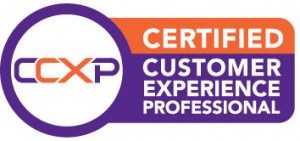Interview: learning from MOO about the link between culture, customers and the certainty of growth
Whatever your definition of Customer Experience, it’s a means to a commercial end and not a platitudinous end-game in itself. It’s a way of being better at business and that’s especially important to those holding the purse strings where having confidence about the returns is everything.
But a cost-benefit analysis is only credible if the assumptions upon which it is dependent are given a culture in which they can become reality. I therefore want to find out if those putting up the money could see culture and customers’ experiences as a better predictor of ROI than a spreadsheet calculation. To help me on my quest, I met recently to speak with Dan Moross of MOO.
Customers of MOO rave about what it’s like to do business with them. Tech gurus and start-up commentators have them on their “ones-to-watch” lists. And this nine-year old web-to-print company seems to have little problem attracting top talent and securing investment.
They must be doing something right so I’m keen to know how a company increases its chances of success and what roles customer experience and employee engagement play in that. I want to know if the positive customer feedback and positive investor sentiment is a happy coincidence or deliberate cause-and-effect.
Being confident about future business growth is about making the right decisions about investment and resource. How we use these finite commodities is often based on a mechanical cost-benefit calculation, the bit we flick to first in a business case. However, the likelihood of that ROI being realised is totally dependent on something rarely assessed to the same degree – the culture.
Is that a fluffy nice-to-have or an essential characteristic of a successful business?
Proving it, quantifying it and justifying it are all harder to do especially when the audience to be won over is a sceptical investor such as a venture capitalist or finance director. Meaningless platitudes, buzzwords and excuses of legacy systems don’t cut it. Certainty and predictability do, so I want to understand how reliant that commercial confidence is on having engaged employees who deliver the right customer experiences.
I meet Dan at MOO HQ – a whitewashed, converted warehouse in the bustling backstreets of London’s Shoreditch. It’s a light, airy and spacious workplace, made more so by relocating the heavy printing machinery to accommodate the growing number of people in its team, or crews as they are called here. It’s friendly, energetic and has the confidence of a company that’s perfectly at home in using design and technology to bring together the best of the digital and physical worlds.

Dan Moross, Director of Customer Services at MOO
At a quick glance, MOO’s proposition is simple. They’ll print your business cards and business stationery and they want you to go away feeling good about it. But look a little further and there is something very exciting going on here and it’s all rooted in the culture.
Dan is MOO’s Director of Customer Services but as job titles go he’s much more comfortable with the website’s more straight-talking version: “He’s in charge of making sure everyone is happy with their order”. It’s his passion, he tells me, never happier than when making one of his customers happier.
We pass two huge TV screens that track real-time performance. Nothing new there. But it’s not call volume, average handling time, or agent availability on show, that type of data is collected and shared elsewhere. The purpose is to help build the connection between customers and employees. One screen relays in real-time what customers are saying about MOO on social media. The other celebrates every customer purchase with a picture of the order, which country they are in and whether it’s their first, second or twentieth order. It’s the digital version of ringing a bell every time there’s a sale.
Dan has been with MOO since the very start and as I learn later, didn’t consciously set out to manufacture a culture. They simply did what felt right and it’s paid dividends as the past has put MOO in a strong position for the future. They have just been awarded a multi-million pound rolling credit facility by Barclays’ new Fast Tech Growth Fund. MOO is in the Future Fifty, a showcase of the UK’s brightest digital businesses. It recently appointed a chairman whose CV includes top jobs at LoveFilm and Mothercare.
And customers like them a lot, evangelical even. They serve people in over 200 countries and have offices popping up around the world. Their Net Promoter Score, based on the totality of the experience is something many organisations will seek but rarely achieve. On Trustpilot they have a score of 9.4 out of 10, with 86% giving the full five stars.
Not surprisingly then, the company is justifiably proud of what it’s done and confident about the future too. “For our customers, quality and premium is standard. We want people to be thrilled with what they get from us. We’re the Apple of printing. If anyone’s going to disrupt the market we’ll make sure it’s us”.
Those are not convenient sound-bite aspirations, the mindset is one of a business that’s already there. They may not be the cheapest but they know very well that people will indeed pay a premium for the right experience. They also know they can’t be complacent and that however good the experience is today, it will need to evolve to ensure the business evolves.
So inevitably, MOO will fly the start-up nest and move into what Dan describes as the next and hardest phase; continuing the rapid growth that investors demand while protecting what got them there in the first place – outstanding customer service. Certainty of growth is what makes them attractive to investors and talented people. The risk is simple: lose the growth and everyone loses interest.
MOO knows that the brand is only as good as customers tell each other it is. It’s the reason why MOO’s growth in future will be focused on helping its customers through design and technology. Crucially though, there’s an acknowledgment that creativity and digitalisation alone are not enough.
Dan talks about how important MOO’s people are. “They work hard, take the job seriously but also have some fun along the way. We encourage people to be part of MOO’s culture, part of the customer experience. People who work here are part of a community. They’re ambitious. They do a good job, look out for each other, tackle things together and love what they do.”
“We’ll hire those who are good at their job but we also want people who are already passionate about design, technology and human beings. And we want to feel we could go to the pub with them”.
Cultural fit is not the sole preserve of customer services either. People joining for non-customer facing roles such as Legal, HR, Marketing and Finance are expected to be every bit as part of the community, immersed in and helping to preserve the brand, as anyone else. Those who start at MOO will spend time in most other parts of the organisation to create a better understanding of each others’ role, contribution and challenges.
Having the right culture that leads to the right commercial outcomes doesn’t happen by accident and I’m intrigued how that happens. Dan smiles proudly. “We didn’t set out with a piece of paper and write a policy. It’s just been organic. Nothing is prescribed. No-one likes to be told what to do. It’s implied, not scripted. It’s about outcomes and we give our people the tools that allow that to happen. We trust our people. We don’t want them to lose their personality, their creativity and their engagement. If they do, they won’t give great customer service.”
The slightly maverick anti-corporate tone belies the fact that the business is as tightly run as any serious commercial operation. There are effective controls in place everywhere, vast reams of data are analysed to drive efficiencies and a robust performance management process ensures that and risks are addressed before they become issues.
Trusting people to be creative leads us on to talk about MOO’s customer promise: “We move heaven and earth to make sure you’re happy with your order”. It’s something that would make most finance directors and lawyers nervous. But it’s that very approach which fuels the growth FDs are looking for – customers buying again, buying more premium products and telling others to do the same.
The result is an upward spiral, one key benefit of which is a gross margin that creates headroom for doing things differently and better than their competitors. Reprinting a pack of business cards at no additional cost to the customer because of a typo, even where it was the customer who made the mistake, is done without flinching or escalating.
It’s that kind of empathy with what’s emotionally important to their customers that influences people to buy from one company over another. Competitors could replicate the promise but if they don’t replicate the culture, it will get treated it as an incremental cost and won’t last beyond the pilot stage. Culture, it’s clear already, is a real competitive differentiator.
Making its customers feel important is not an empty promise. Many companies try to put themselves in their customers’ proverbial shoes to get to know them better. MOO though, already has a genuine affinity with its customers. Dan explains, “We might have the best part of 400 employees but we were a small business once, like most of our customers now. We identify with them”. MOO now has large global corporates as clients but back in the day they could easily have been one of their own customers. “We think like them”, Dan asserts.
For a company whose future is so reliant on technology, it means they must also be dependent on another quality that many businesses struggle with: change. They have kept their tech development in-house and despite being a confident start-up, MOO has internal challenges common to most organisations. Securing project resource where demand outstrips supply, prioritising IT activity where there is a finite budget and questioning whether they are too nice to customers.
So I’m interested in whether having such engaged people makes it easier to lobby for, and deliver, the right changes. “Yes it does, but the stage after start-up is the most difficult. It’s one thing to be nimble and fun but rapid growth means it’s even more important to instil the original ethos and keep the start-up mentality in a workforce that’s very new to the company. It’s also about having the right processes for the right people. The culture, our future, is our people”.
Dan’s final thought on what keeps him and the crews pursuing the next level of success is typically understated. “Work should be enjoyable. The day it stops being exciting is the day we all stop”.
I ask if there’s any scepticism internally about the link between good customer service and commercial success. “That’s not even debatable. Our business relies on people coming back because the products are good. They know we’ll help them get what they need, when they need it. If we degrade the customer service simply to prise open margins a bit, we won’t be able to do what we do. We won’t be any different, people will be less likely to come back and it will cost rather than make money as a result. If we do that the predictability of our business dies”.
Do investors see it that way too and believe that engaged customers and employees are essential for predictable growth? Dan’s reply is emphatic.
“Investors value it massively. They’re also very proud to have something so highly regarded in their portfolio.” And if you think about it, customers are investors of a sort too and they’re making it very clear that they like being on the receiving end of the right culture.
So is culture a better predictor of ROI than a number on a cost-benefit spreadsheet? There’s a place for both but the numbers mean little if there’s not the values to turn them into reality. For me then, possibly predictably, it’s a certainty.
The author Jerry Angrave wishes to express sincere thanks for Dan Moross of moo.com for being so generous with his time and for sharing his thoughts.
Thank you for reading the blog, I hope you found it interesting and thought-provoking. I’d love to hear what you think so please feel free to add your comments below.
I’m Jerry Angrave, an ex-corporate customer experience practitioner and since 2012 I’ve been a consultant helping others understand how best to improve their customer experiences. If you’ve any questions about nurturing customer centric cultures or any other CX issue do please get in touch for a chat. I’m on +44 (0) 7917 718 072 or on email I’m [email protected].

Jerry Angrave

![]()

Leave a Reply
Want to join the discussion?Feel free to contribute!